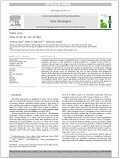| Journal Article |
 |
|
| Article Title | How to be an ant on figs | | Author | Anthony Bain, Rhett Daniel Harrison and Bertrand Schatz | | Year | 2013 | | Journal Title | Acta Oecologica | | Institution | Elsevier Masson SAS. | | Pages | 1-12 | | Call Number | JA0538-14 | | Keywords | Agaonidae, Ants, Anteplant interactions, Ficus, Fig wasp, Mutualism, Pollination, Tropical forest |
|
| Abstract: |
| Mutualistic interactions are open to exploitation by one or other of the partners and a diversity of other
organisms, and hence are best understood as being embedded in a complex network of biotic interactions.
Figs participate in an obligate mutualism in that figs are dependent on agaonid fig wasps for
pollination and the wasps are dependent on fig ovules for brood sites. Ants are common insect predators
and abundant in tropical forests. Ants have been recorded on approximately 11% of fig species, including
all six subgenera, and often affect the figefig pollinator interaction through their predation of either
pollinating and parasitic wasps. On monoecious figs, ants are often associated with hemipterans,
whereas in dioecious figs ants predominantly prey on fig wasps. A few fig species are true myrmecophytes,
with domatia or food rewards for ants, and in at least one species this is linked to predation of
parasitic fig wasps. Ants also play a role in dispersal of fig seeds and may be particularly important for
hemi-epiphytic species, which require high quality establishment microsites in the canopy. The intersection
between the figefig pollinator and anteplant systems promises to provide fertile ground for
understanding mutualistic interactions within the context of complex interaction networks. |
|
|
Download file(s): Click icon to download/open file.
|
| |
File Size |
Description |

|
1,514 KB |
Softcopy |
|
|
|
| Viewed in 1050 times. Downloaded in 523 times. |